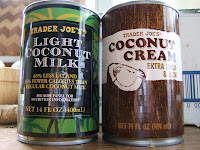It seems that Americans are finally discovering that coconut milk is a great alternative to dairy, which seems kinda weird to consume, considering the fact that cows generally do not drink human milk, right? However, this does not mean that I am against dairy products. I actually use milk in my coffee sometimes and in baking but only in small amounts because of that pesky lactose intolerance issue. Coconut milk, almond milk, and soy milk are all friendlier to my stomach. The coconut water that has recently become popular is kinda weird-tasting. The coconut milk that comes in the milk cartons is also kinda boring. The good stuff is the coconut milk that comes in cans.
Read the nutrition label!
When you pick up a can of coconut milk, it's important to read the label because the lighter stuff will be good for a lot of recipes but if you want to make some richer tasting things like chocolate coconut whipped cream, you need the full fat stuff. Some of the Asian brands have cans that look quite similar. For example, Chaukoh and Chaudoc have similarly designed cans (see pictures below). However, Chaukoh is the full fat version and Chaudoc is the light version. They label both cans "coconut milk". By the way, these are great brands and you can find them at Super 88/Hong Kong Supermarket in Allston. You can also find both the light and full fat versions at Trader Joe's under their labels. All of the coconut milk shown in the pictures below come from Thailand. However, if you compare the full fat versions, the Trader Joe's brand actually has a more calories per serving (1/3 cup) and it is labeled as "coconut cream" to make it extra obvious. There is only one extra gram of saturated fat in the Trader Joe's version (over Chaukoh) though.
(Click on the pictures to see larger images)
 |
| Can you see the difference? |
 |
| Check the nutrition labels! |
 |
| The Trader Joe brands |
 |
| Light on the left, Full fat on the right |
 |
| The Light brands |
 |
| The Full fat brands |
 |
| Chaudoc Coconut Milk (full fat) |
 |
| Nutrition label for Chaokoh coconut milk (full fat) |
 |
| Nutrition label for Chaudoc coconut milk (light) |
Ice cream
The lighter stuff will generally be a bit cheaper and is pretty good for most things, including ice cream. Just make sure you churn it long enough to get the air into the ice cream so it doesn't freeze solid. In Boston, JP Licks has recently been offering a few coconut milk flavors, in case you'd like to try it before attempting to make it at home. Coconut is a great complement to chocolate. Check out my post on
making dairy-free ice cream. It really takes only 3 ingredients: coconut milk, sugar, and cocoa. If you're planning on freezing some for later, add a tiny bit of vanilla extract near the end of the churning time because the alcohol will prevent the cream from freezing solid.
If you use Dutch cocoa with honey (instead of sugar), and full fat coconut milk, the result will be pretty close to premium ice-cream quality. This is where you might want to use the coconut cream with the highest fat content, such as the Trader Joe's brand. A can of coconut milk is usually somewhere between $1.70 to $2 and it will make at least a pint of ice cream. You might never buy factory-produced ice cream ever again!
 |
Chocolate ice cream made with 3 ingredients:
coconut cream Dutch cocoa, and raw honey |
 Coffee Creamer
Coffee Creamer
One thing that hasn't caught on yet is using coconut milk as a coffee creamer. It's a great alternative to soy milk and dairy milk. If you use the full fat stuff, it's as rich as (or maybe even richer than) half and half. However, because coconut oil solidifies at cold temperatures, the full fat coconut cream is ideal for hot drinks and might not work so well in iced drinks. The lighter coconut milk seems to work well in iced coffee. Some people don't like the "bean-y" taste of soy milk. Perhaps the coconut flavor won't be as weird for them.
Places to buy coconut milk:
Cans of coconut milk are readily available in most Latino stores,
Asian markets, and even CVS. The Goya brand is probably the most popular one in the U.S. However, if you sample several brands, you'll find that some brands will have different characteristics. For instance, the Chaokoh brand does not separate as cleanly as some other brands. I put a can of Chaokoh (full fat) coconut milk in the fridge over night to let the coconut cream separate from the liquid. The liquid part was actually thick enough to be coconut milk (it was white and not clear) and the coconut cream was not solid but had the consistency of runny whipped cream. With other brands, you might get a thick layer of nearly solid coconut fat on top of what looks like clear coconut water. Depending on what you're going to do with it, you might want that layer of coconut fat. I used the Chaokoh to make the ice cream you see in the pictures above.








